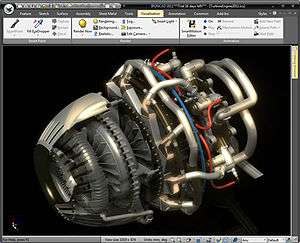IRONCAD
IRONCAD is a software product for 3D and 2D CAD (computer-aided-design) design focused mainly on the mechanical design market that runs on Microsoft Windows. It is developed by Atlanta, GA based IronCAD LLC.
 IRONCAD user interface | |
| Original author(s) | Visionary Design Systems (VDS) |
|---|---|
| Developer(s) | IronCAD LLC |
| Initial release | 1998 |
| Stable release | IRONCAD 2020SP1
|
| Type | CAD |
| License | Proprietary |
| Website | www |
History
IRONCAD was originally developed by Visionary Design Systems (VDS) based in Santa Clara, CA. The product launched in 1998.[1][2] In 2001 the development team led by Dr. Tao-Yan Han split from VDS (now known as Alventive) to form IronCAD LLC to continue the development of the IRONCAD product.[3]
IronCAD descended from a product called Trispectives, developed by 3D Eye, an Atlanta-base company that was acquired by VDS.
Release History
| Version | Release Date |
|---|---|
| 1.4 | August 1998 |
| 2.0 | May 1999 |
| 3.2 | January 2000 |
| 4.0 | December 2000 |
| 4.2 | June 2001 |
| 5.0 | October 2001 |
| 5.2 | May 2002 |
| 6.0 | February 2003 |
| 7.0 | June 2004 |
| 8.0 | June 2005 |
| 8.2 | March 2006 |
| 9.0 | June 2006 |
| 10.0 | November 2007 |
| 11.0 | December 2008 |
| 2009 (12.0) | November 2009 |
| 2011 (13.0) | November 2010 |
| 2012 (14.0) | September 2011 |
| 2013 (15.0) | November 2012 |
| 2014 (16.0) | November 2013 |
| 2015 (17.0) | November 2014 |
| 2016 (18.0) | November 2015 |
| 2017 (19.0) | November 2016 |
| 2018 (20.0) | December 2017 |
| 2019 (21.0) | December 2018 |
| 2020 (22.0) | November 2019 |
Solid Modeling Methodology
IRONCAD primary focus is on 3D CAD design using solid modeling technology. IRONCAD uses both Parasolid and ACIS modeling kernels to provide computational methods for solving geometric calculations such as calculating blends and shells. Users create designs in 3D using a drag and drop design methodology by dragging and dropping shapes and components from 3D catalogs to build parts and assemblies. They then use those designs to communicate with other users in the design process using both 3D models and 2D drawings. The drawings remain associative to the 3D model so as the model is updated the drawings reflect the changes. IRONCAD also employs the use of direct face editing and allows the combination of features and direct face edits within the same part.
To assist people in learning products many users have written books on IronCAD's products to assist customers in training of the software.[4][5]
References
- "History Based Direct Modeling Using IRONCAD – Part 1 | Deelip.com". deelip.com. Retrieved 2015-09-25.
- "IronCAD 4 - the CAD-Reviews independent review". cad-reviews.com. Retrieved 2015-09-25.
- "Alventive, Inc. Spins-Off IronCAD, LLC; Employee-Owned Company Will Focus on Solid Modeling Technology. - Free Online Library". thefreelibrary.com. Retrieved 2015-09-25.
- Jerry Craig. Computer Modeling for Design Using Ironcad 5.2 and Inovate. Schroff Development Corporation. ISBN 1585031070. Retrieved 2012-09-26.
- Rendow Yee. Architectural Drawing: A Visual Compendium of Types and Methods. John Wiley & Sons. Retrieved 2012-09-26.